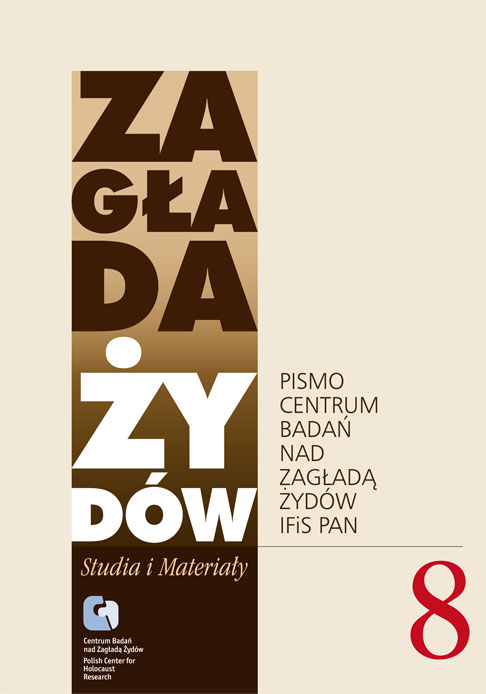Odmienne sylwetki przybyłych do Szwecji więźniów pochodzenia żydowskiego i nieżydowskiego, ocalałych z obozów koncentracyjnych na ziemiach polskich
Zagłada Żydów. Studia i Materiały, Nr 8 (2012), Strony: 419-429
Data zgłoszenia: 2020-12-06Data publikacji: 2012-12-02
 https://doi.org/10.32927/zzsim.698
https://doi.org/10.32927/zzsim.698
Abstrakt
Survivors from Nazi concentration camps, who were brought to Sweden as refugees during the last month of the Second World War and during the summer that followed, were often required to supply information about personal details to the authorities. Much of the information was later stored in written form in the Swedish National Archives. Antisemitism among the refugees and enmity between the Jewish and non-Jewish Polish refugees caused the authorities to include their ethnic or religious affiliation in many records and documents. Using mainly two collections from the Swedish National Archives it is shown that substantial differences existed between Jewish and non-Jewish Polish refugees with respect to their age, education and the length of their war experiences. These differences, in addition to the existing socio-geographic, demographic, cultural and ethnic differences led to inevitable clashes between the two groups. The Swedish authorities who first regarded all refugees of Polish citizenship as one national group had to revise this attitude gradually during the administration of the refugees
Słowa kluczowe
ocalali z Zagłady , Szwecja , stosunki polsko-żydowskie
Licencja
Prawa autorskie (c) 2012 Autor&"Zagłada Żydów. Studia i Materiały"

Utwór dostępny jest na licencji Creative Commons Uznanie autorstwa 4.0 Międzynarodowe.
https://creativecommons.org/licenses/by/4.0
Czasopismo publikowane jest w standardzie Diamond Open Access na licencji CC-BY-4.0 Deed - Uznanie autorstwa 4.0 Międzynarodowa - Creative Commons
Podobne artykuły
- Romuald Jakub Weksler-Waszkinel, Jak Pawłowski ukrywał Grinera [Sługa Mesjasza. Z ks. Grzegorzem Pawłowskim/Jakubem Herszem Grinerem rozmawia Lucyna Montusiewicz, Lublin, wyd. Gaudium 2005] , Zagłada Żydów. Studia i Materiały: Nr 1 (2005)
- Marek Bem, Ci, którzy przeżyli Sobibór , Zagłada Żydów. Studia i Materiały: Nr 5 (2009)
- Grzegorz Krzywiec, O klerykalnym faszyzmie (Na marginesie Curriculum Vitae Jędrzeja Giertycha) , Zagłada Żydów. Studia i Materiały: Nr 9 (2013)
- Zuzanna Schnepf-Kołacz, „Write your story” – seria wydawnicza Makor Jewish Community Library , Zagłada Żydów. Studia i Materiały: Nr 3 (2007)
- Marta Witkowska, Michał Bilewicz, Czy prawda nas wyzwoli? Przełamywanie oporu psychologicznego w przyjmowaniu wiedzy o Zagładzie , Zagłada Żydów. Studia i Materiały: Nr 10 (2014)
- Dariusz Libionka, The Fighting and the Propaganda: The Uprising in the Warsaw Ghetto from the Perspective of ‘Polish London’ , Zagłada Żydów. Studia i Materiały: Nr Holocaust Studies and Materials (2017)
- Łukasz Biedka, Pamiętnik Cesi Gruft "W Imię Boże!" , Zagłada Żydów. Studia i Materiały: Nr 5 (2009)
- Anna Bikont, „Raz napadł na nas młody chłopak i strzelał, myśmy już nie uciekali”. Morderstwa popełniane przez członków AK i BCh na Żydach ze wsi Strzegom , Zagłada Żydów. Studia i Materiały: Nr 10 (2014)
- Sławomir Buryła, Literatura polska o donosach i donosicielach , Zagłada Żydów. Studia i Materiały: Nr 2 (2006)
- Michał Głowiński, Błoński’s Essay Years Later , Zagłada Żydów. Studia i Materiały: 2008: Holocaust Studies and Materials
<< < 1 2 3 4 5 6 7 8 9 10 11 12 13 14 15 16 17 18 19 20 21 22 23 24 25 26 27 28 29 30 31 32 33 34 35 36 37 38 39 40 41 42 43 44 45 46 47 48 49 50 > >>
Możesz również Rozpocznij zaawansowane wyszukiwanie podobieństw dla tego artykułu.
 English
English
 Język Polski
Język Polski




